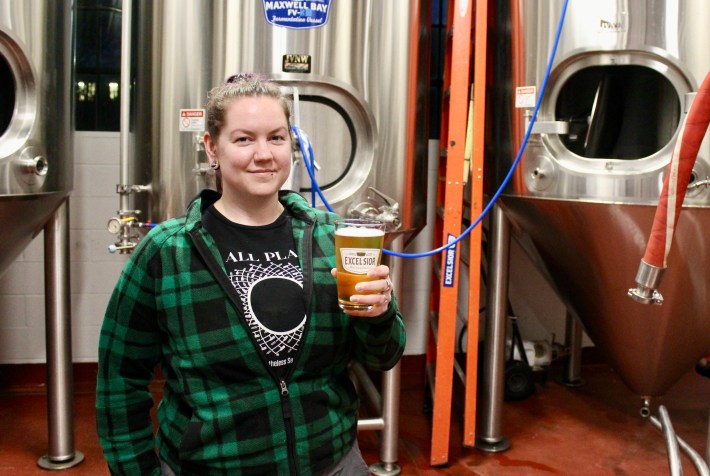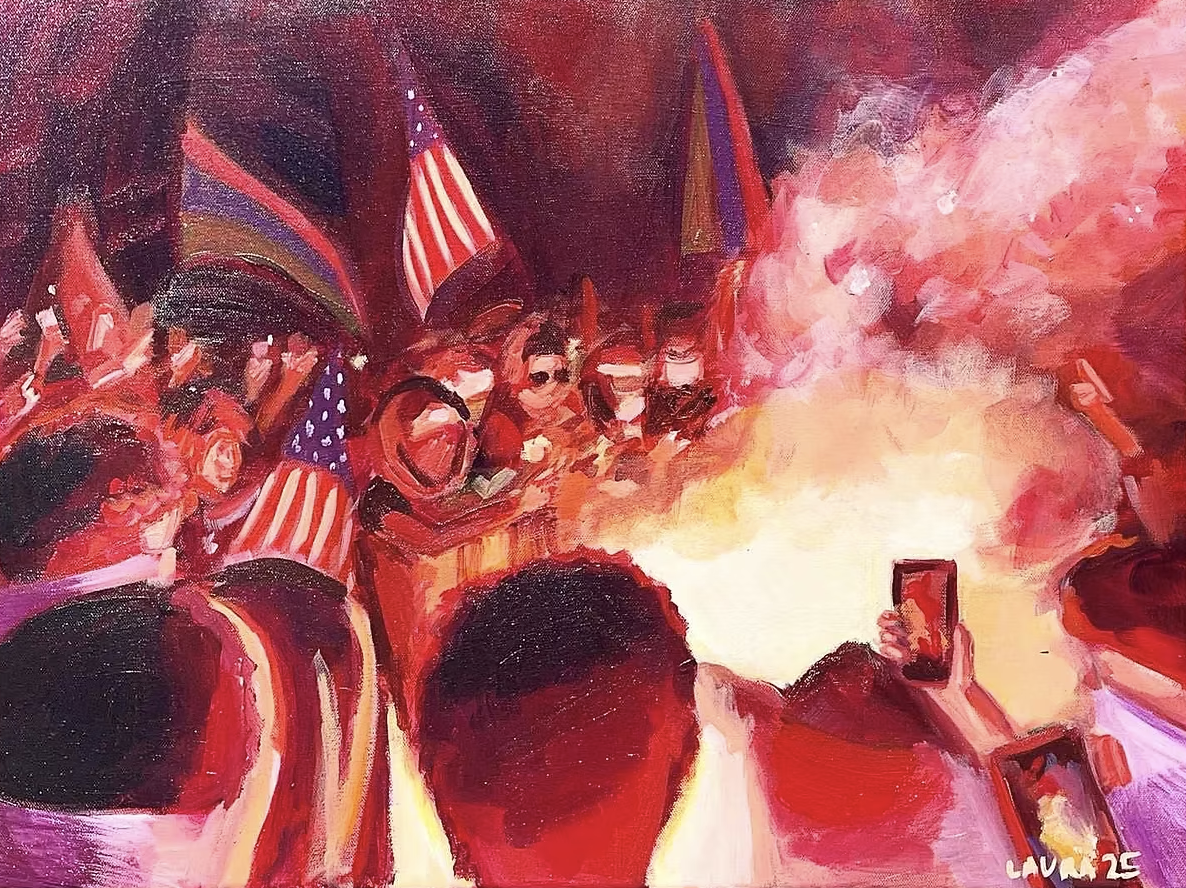Dan Herman knows something that’s true of all beer drinkers: “Everybody has their cheap-shit beer they prefer.” For Herman, corporate revenue officer at Falling Knife Brewing Co., it’s Hamm’s, followed closely by Coors Banquet.
As we talk, we’re sipping pints of Tomm’s. The crisp, golden lager under dim lighting harkens to some nondescript hometown bar more than a northeast Minneapolis taproom. I picture a time when beer cans were popped open with a church key, glass bottles imbued quality, and coolers held nearly identical, ice-cold American light lagers.
Named after the Falling Knife’s chief brewing officer, Tom Berg, Tomm’s delivers “The Taste You Remember,” according to its packaging. The label’s jaunty cursive letters and soft, primary colors play into that, along with the can’s gold top.
Falling Knife isn’t the only Minnesota brewery using this trick in recent years. “We're all trying to lean on the nostalgia of it,” Herman says.
Steve Finnie, head brewer and co-founder of Rochester’s Little Thistle, views his light lager, The Doug, similarly. “It's the kind of lager that my father-in-law—an 80-year-old, retired farmer from Iowa who used to drink Milwaukee's Best—can drink,” Finnie says.
After years of discussion about a craft lager revolution, it almost feels like a bait and switch that these light lager clones are ascendant. However, what seems like a lucrative decision to make bargain products is fraught with technical difficulty, scheduling concerns, and “lite” margins.
So why are so many breweries making them?

Who’s brewing American light lager?
Ready for a noncomprehensive list?
Twin Cities-area breweries making this style of nostalgically branded lighter beer include Barrel Theory Beer Co. (BT Lite); Elm Creek Brewing Co. (Simple Fresh); Fair State Brewing Cooperative (Union Lager, a collab with August Schell Brewing Co.); Fulton Beer (Chill City Chugger); Saint Paul Brewing, which is located in the old Hamm’s brewing facility (Shamm’s); OMNI Brewing Co. (OMNI Lager); and Venn Brewing Co. (Bull Brand and others). Looking to Greater Minnesota, there’s Bent Paddle in Duluth (Light), Castle Danger in Two Harbors (Lager Royale), and Revelation Ale Works in Hallock (Kittz).
And when you add breweries making a classic-tasting style without the kitsch, the list grows much longer. The team at Dabbler Depot pointed me to excellent examples from Dangerous Man Brewing Co. (Danger Lite), Portage Brewing Co. (Zero Day Lager), and Giesenbräu Bier Co. (Town Ball Lite).
The American light lager—a term we'll use broadly throughout to encompass styles ranging from Budweiser to Michelob Golden Light—might seem like an unusual move for a brewery that focuses on classic German and Czech styles. But Erin Hutton, owner of New Prague's Giesenbräu Bier Co., wanted to make a light lager that his in-laws enjoy on hunting trips instead of Busch Light. Then local baseball fields started serving it, and it soon went into distribution.
“It started as us just being like, ‘Hey, we can brew a lager that is basically the same thing as Busch Light, but it'll be 10 times better,” Hutton says. “And it really took off.”
Straddling the line is Excelsior Brewing Co. Its Lakestyle Lager shows some inspiration from olden-days Miller Lite, but with several icons that seem like they could’ve been pulled from the graphic design website Canva. The recent 13 Folds Light American Lager offers a lighter taste that brewer Ariel Keeton describes as “the Excelsior Coors Light.”
“There is something so nostalgic and relatable about crisp light lagers,” Keeton says. “You can drink them in the middle of the summer in July and not feel like you're gonna die. And you can drink them in the middle of wintertime, and it's just refreshing.”
The growth of light lager stems from the intense flavors craft breweries have kicked out for over a decade, adds Venn CEO Kyle Sisco. During the pandemic, trends exploded as microbreweries grasped at anything to make sales.
“Brewers have had palate fatigue for longer than consumers have because we have to taste the stuff we're making for consumers every day,” he says. “By the time we're done with work, we want something light and refreshing to offset the barrage of flavor we've had to endure.”
It could be something from Schell’s, to whom Venn pays tribute with its Bull Brand and other offerings like Creamium. Venn made Bull Brand in collaboration with neighboring south Minneapolis staple Bull’s Horn Food & Drink, and they actually dialed back its original Deer Brand copycat branding prior to distribution.
“I hope they don't hate us,” Sisco says. “We're really big fans!”
But above all the classic light lagers out there, here in Minnesota, Hamm’s is king. Most breweries keep Hamm’s—which launched in St. Paul over 150 years ago—in the cooler during construction and onward. Beyond the classic, easy-drinking taste, brewers respect Hamm’s and other macrobeer’s uniformity despite the style’s nuances. And the low ABV doesn’t hurt.
“It just happened one day where I started drinking Hamm's with other brewers,” Keeton says. “I did a collaboration at Wooden Ship a few years ago, and they were like, ‘We have Hamm's or something on draft.’ I was like, ‘Well, I'll have a Hamm's because it's 10 a.m.’”

Nowhere to hide mistakes
American light lagers are crisp, clear, bright, and bubbly. The minimalist ingredient list includes two-row barley, flaked corn, hops, and yeast, with minor differences here and there.
“The challenge is what makes it fun for brewers,” Sisco says. “Most people know that lightly flavored beers are the harder styles to brew well because there's less character for flaws to hide behind. World-class examples often only differentiate themselves by minute subtleties because the spectrum of flavors is tiny compared to the breadth of variety among something like pale ales.”
Another challenge is scheduling. Unlike ales that ferment for a few weeks, the lagering process takes twice as long. Falling Knife experienced this untenable cycle in the early days of Tomm’s.
“It takes about six weeks to make, and we would sell out of it in about three or four,” Herman says. “If we're taking twice as much time as it takes to make a hazy to make this beer, part of that doesn't make sense.”
Finding capacity offsite is one answer, either through contract brewing, where another brewery makes your recipe, or an alternating proprietorship where you use another brewery’s equipment. Falling Knife chose the latter to make nearly all Tomm’s in 80-barrel batches (about 2,500 gallons) at Fulton’s production facility. Venn has a similar arrangement at Insight Brewing Co.
For smaller operations like Little Thistle, scheduling is key. A reference to the Douglas State Trail, The Doug was part of Little Thistle’s opening lineup in 2018. The nostalgia branding came later, during the pandemic, when they canned it and received a grant to work with a local design firm.
With inflation, consumers’ beer budgets have declined in recent years. And data from the Brewers Association has shown an uptick in light lager, according to Finnie.
“For me, it was always a no-brainer,” he says. “The majority of the world drinks light lagers. So if you're a small craft brewery, why wouldn't you make one?”

Your local microbrewery’s macrobeer
No matter the marketing, cost is a challenge. Craft-made light lagers trend cheaper than, say, hazy IPAs, but might still to be too spendy for bargain drinkers.
Beyond that, Giesenbräu's Hutton doesn’t think trying something new appears to be an option to the typical [insert lite beer brand here] loyalist. Even when he's handing out samples at a liquor store, people who buy the same case every week walk past without really noticing.
“We're brewing Town Ball Lite because it's a lighter beer that's easy to drink, but it still appeals to a craft beer drinker that doesn't want to drink a 7-8% IPA,” Hutton says. “They still want to support craft. They want to support local. They want to support fresh beer that tastes good.”
This idea remains a point of pride for locals and a reason to branch out for others. And it’s the principle that must keep sustaining small breweries, according to Venn's Sisco.
“Consumers still seem to appreciate diversity and new experiences rather than focusing on singular brand loyalty like they did 30 years ago,” he says. “My guess is that consumption in this sector of the market will vastly be consumers shifting their purchases from local brewery to local brewery and trying a wide variety of light lagers.”
Brewers see this as a reward in itself, adds Keeton from Excelsior Brewing Co.: “You can create your localized Coors.” However, she’s unsure about the future of the nostalgic American light lager trend. Right now, she’s happy to focus on straightforward, technically savvy brewing. If it’s a beer that she enjoys, that brings back memories for others, that welcomes beer craft newcomers—all the better.
“Even though we're at a decade or more of the craft beer scene in this state, there are still people that haven't really explored much,” Keeton says. “This is an easy way to do that.”







